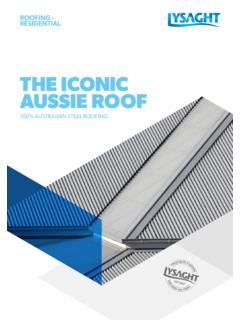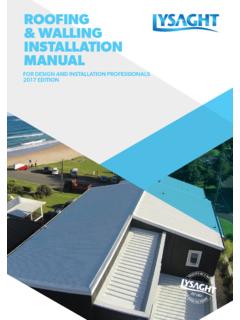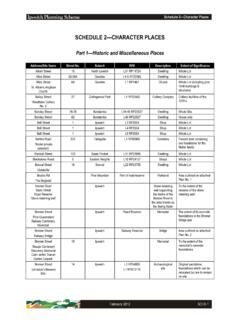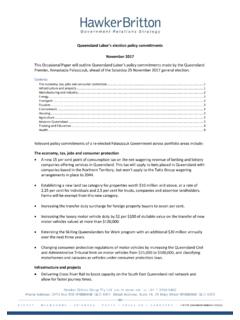Transcription of RAINWATER SOLUTIONS - lysaght.com
1 RAINWATER SOLUTIONSQUEENSLANDRAINWATER SOLUTIONS2 The most common means to satisfy these requirements for roof drainage ( guttering) installations is via compliance with the AS/NZS , in each state and territory it is necessary to satisfy the relevant the design and detailing of a roof drainage system consideration must be given to a range of the factors such as rainfall intensity, roof catchment area, gutter size/capacity, gutter fall, gutter outlets (sumps, rainheads, nozzles), downpipe size, quantity and placement, overflow consideration, material selection, jointing, is the responsibility of designers and installers of roof drainage systems to ensure compliance with these INFORMATION ON OVERFLOW MEASURES For residential roof drainage systems, high fronted gutters are a popular aesthetic choice to hide the lower edge of tiles or roof cladding.
2 Where high-fronted gutters are installed, the NCC (and AS/NZS ) requires that provision must be made to avoid any overflow back into the roof or building simple overflow control methods that can be employed on high fronted gutters are listed below. It is important to note that it may be necessary to use more than one of these measures to achieve the necessary result:A) Methods related to the design and installation of roof drainage systems: Slotted front of gutter simple and popular choice which allows for water overflow through the slots visible on the front face of the gutter; Specifically located non-continuous overflows as permitted in the NCC : - Inverted downpipe drop/pop at high points in the gutter but set at a level below the fascia top, -Stop ends cut down to a lower level to act as a weir (stop end weirs could be hidden at the high point of the gutter and designed as part of an expansion joint), - Rainheads with overflow weir, -Holes, slot, or weir at downpipes; Gap between the fascia and the gutter back a packer is inserted between the gutter back and the fascia.
3 Or Any of a number of other proprietary systems and trade ) Methods related to alternative building designs methods: Unlined eaves eliminates the issue where the house design suits. Gutter installed such that the gutter front is fully and sufficiently below the top of the fascia (freeboarding). Design for a higher rainfall intensity, as used for internal box gutters. Back flashing where gutter support brackets allow back flashing installation ( external brackets).The following illustrations show some typical continuous and non-continuous overflow measures that may be used in combination with each other or with other overflow measures to meet the necessary note that non-continuous measures may become blocked anywhere along their length, so non-continuous overflow measures may not be sufficient to prevent water from flowing back into a gutters may also provide an overflow measure, however slots must be of sufficient size.
4 For this reason, slots alone may not be a sufficient overflow measure in all circumstances. When designing a roof drainage system with slotted gutter, consideration should be given to additional overflow SOLUTIONSU nder the Environmental Planning and Assessment Act 1979 and its Regulations, all building work must be carried out in accordance with the ABCB National Construction Code 2016 (NCC). In addition to referring to Australian Standards AS/NZS :2015 Plumbing and Drainage Stormwater Drainage, the NCC also contains requirements for the disposal of surface water in Volume One, in Performance Requirements and , and in Volume Two, in Part , namely, Performance Requirements and Clauses and overflow in domestic RAINWATER systemsTypical overflow from slotted gutter.
5 (Gutter shown is not available in all areas). RAINWATER SOLUTIONS3 DESIGN AND INSTALLATION OF DOMESTIC ROOF DRAINAGE SYSTEMSThe detailing and sizing of the selected overflow method/s is normally completed by the designer/installer, but must be adequate for the situation and must meet the relevant performance requirements of the NCC and Australian Standards, including the requirements noted there may be some variations from state to state, contractors who install guttering systems are generally required to hold an appropriate licence. Where a license is required it is an offence to undertake this work without an appropriate licence.
6 The work is required to comply with the appropriate codes and warranties normally apply and consumers have a right to lodge a complaint and have it dealt with by the appropriate the installation of the roof drainage system, particular focus should be given to the following; Attention to the use of compatible materials for drainage system components, leaf-guard type system components and compatible fasteners/sealants to connect and seal the components. The position of the gutter in relation to the fascia (particularly, whether there is a gap between the fascia and the gutter back and whether the gutter front is below the top of the fascia).
7 Installation of the specified gutter and downpipes, ensuring that downpipes are installed in the correct locations and numbers. Gutter fall, ensuring sufficient fall and that it is in the direction of the downpipes. Overflow has been considered and specific details are installed where required as described above (such as when the gutter front is higher than the top of the fascia).During the installation all debris and loose waste materials (swarf, fasteners, etc.) must be cleaned off at the end of each day and at the completion of the installation to prevent blockages of the drainage system or deterioration of the individual components.
8 Any protective films should also be removed as part of the installation OF DOMESTIC ROOF DRAINAGE SYSTEMSIn the longer term, the ability of a roof drainage system to handle overflow will also depend on the regular cleaning of the system. For example the removal of plant or animal matter (leaves, fungal growth, dropping, nests, etc.) and debris from gutters, leaf-guard type systems and the gutter overflow devices to ensure free drainage of ensure the long life of the roof drainage system, the maintenance requirements of the roof drainage system should be forwarded to the occupier/owner of the building and should be fulfilled.
9 Adequate maintenance is a requirement of RAINWATER goods (full length) overflow measuresGutterFasciaFront of gutter below top of fasciaGutterGap between gutter and fasciaNon-continuous (specifically located) overflow measuresGutterDownpipe nozzleFasciaInverted nozzle at high ends of gutterfinished below back of gutterStop ends finished below the top of the fascia and rear of the gutter to form a weirGutterRAINWATER SOLUTIONS4 Information on designing a perimeter drainage system for a domestic roof1. Decide on the average recurrence interval (ARI). Where significant inconvenience or injury to people, or damage to property (including contents of a building), is unlikely (typical of an eaves-gutter system) a minimum ARI can be 20 years.
10 If these conditions are likely (typical of box gutters) 100 years is Determine rainfall intensity for the site from Table 1. More data are in AS/NZS Sketch a roof plan showing dimensions in plan view, pitch of roof, layout of ridges and valleys and large roof Calculate the catchment area of the roof from the plan. To allow for the slope of the roof, increase the plan area. Refer to AS/NZS for the increased area. As a rule of thumb allow 1% for every degree of pitch up to 36 .5. Get the effective cross-sectional area of the gutter you intend to use from Table Using the cross-sectional area of the gutter on the graph in Figure 1, determine the catchment area per Calculate (as a first test) the minimum number of downpipes required for the selected gutter using the equation: Round the number of downpipes up to the next whole On the plan, select locations for the downpipes and the high points in the gutters.















